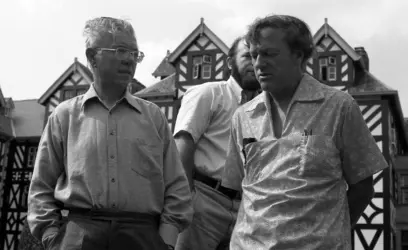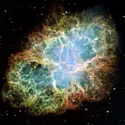HOYLE FRED (1915-2001)
Article modifié le
Bibliographie
Principaux articles de Fred Hoyle
F. Hoyle & R. A. Lyttleton, « On the nature of red giants », in Monthly Notices of the Royal Astronomical Society, vol. CII, p. 218, 1942
F. Hoyle & H. Bondi, « On the mechanism of accretion by stars », ibid., vol. CIV, p. 273, 1944
F. Hoyle, « Note on the origin of white dwarfs », ibid., vol. CVII, p. 253, 1947 ; « A new model for the expanding Universe », ibid., vol. CVIII, p. 372, 1948
E. M. Burbidge, G. R. Burbidge, W. A. Fowler & F. Hoyle, « Synthesis of the elements in stars », in Review of Modern Physics, vol. XXIX, p. 547, 1957 (il s'agit du célèbre « B2FH »)
F. Hoyle & W. A. Fowler, « On the nature of strong radio sources », in Monthly Notices of the Royal Astronomical Society, vol. CXXV, p. 169, 1963 ; « Nature of strong radio sources », in Nature, vol. CXCVII, p. 33, 1963 (ces deux derniers articles ont été écrits avant la découverte des quasars !)
F. Hoyle & G. R. Burbidge, « On the nature of quasi-stellar objects », in Astrophysical Journal, vol. CXLIV, p. 534, 1966
R. V. Wagoner, W. A. Fowler & F. Hoyle, « On the synthesis of elements at very high temperatures », ibid., vol. CXLVIII, p. 3, 1967.
Études
G. Burbidge, « Sir Fred Hoyle. 24 June 1915-20 August 2001 », in Biographical Memoirs of Fellows of the Royal Society, vol. XLIX, pp. 213-247, 2003
D. Gough dir., The Scientific Legacy of Fred Hoyle, Cambridge University Press, Cambridge (G.-B.), 2005
J. Gregory, Fred Hoyle's Universe, Oxford University Press, Oxford, 2005
A. P. Lightman & R. Brawer, Origins : the Lives and Worlds of Modern Cosmologists, Harvard University Press, Cambridge (Mass.), 1990
S. Mitton, Fred Hoyle : a Life in Science, Aurum Press, Londres, 2005
N. C. Wickramasinghe, A Journey with Fred Hoyle : The Search for Cosmic Life, World Scientific, Londres, 2005.
La suite de cet article est accessible aux abonnés
- Des contenus variés, complets et fiables
- Accessible sur tous les écrans
- Pas de publicité
Déjà abonné ? Se connecter
Écrit par
- Marek A. ABRAMOWICZ : professeur d'astrophysique à l'université de Göteborg, Suède
Classification
Média
Autres références
-
BURBIDGE E. MARGARET (1919-2020)
- Écrit par Encyclopædia Universalis
- 792 mots
Astrophysicienne américaine d'origine britannique, Margaret Burbidge est la première femme à avoir été nommée directrice de l'Observatoire royal de Greenwich. Elle a apporté des contributions fondamentales à la théorie des quasars, déterminé les paramètres de rotation, les masses...
-
BURBIDGE GEOFFREY R. (1925-2010)
- Écrit par Encyclopædia Universalis
- 348 mots
Astrophysicien et astronome américain d'origine britannique, Geoffrey R. Burbidge joua un rôle clé dans plusieurs avancées majeures en matière d'astrophysique et de cosmologie.
Né le 24 septembre 1925, à Chipping Norton, dans l'Oxfordshire, Geoffrey Ronald Burbidge obtient une licence...
-
ÉTAT STATIONNAIRE THÉORIE DE L', cosmologie
- Écrit par Marc LACHIÈZE-REY
- 1 015 mots
En 1948, l'Américain Thomas Gold et le Britannique Hermann Bondi publient dans les Monthly Notices of the Royal Astronomical Society (vol. 108, no 3, pp. 252-270) un article intitulé « The Steady-State Theory of the Expanding Universe » (« La Théorie de l'Univers en expansion...
-
NOVAE ET SUPERNOVAE
- Écrit par Jean AUDOUZE
- 3 506 mots
- 8 médias
Le premier mécanisme, appelé modèle de photodésintégration du fer, a été proposé par FredHoyle et William A. Fowler (prix Nobel de physique 1983) et permet d'expliquer l'explosion des supernovae les plus massives : dans les étoiles de masse supérieure à une dizaine de masses solaires, les...
Voir aussi
- LUMINOSITÉ
- SCIENCES HISTOIRE DES, XXe et début du XXIe s.
- HÉLIUM
- PRINCIPE COSMOLOGIQUE PARFAIT
- BONDI HERMANN (1919-2005)
- GOLD THOMAS (1920-2004)
- ACCRÉTION, astrophysique
- FOND DIFFUS COSMOLOGIQUE ou RAYONNEMENT COSMOLOGIQUE
- ASTRONOMIE HISTOIRE DE L'
- EXPANSION DE L'UNIVERS
- MODÈLE COSMOLOGIQUE
- ÂGE DE L'UNIVERS
- ÉTOILES SUPERMASSIVES



